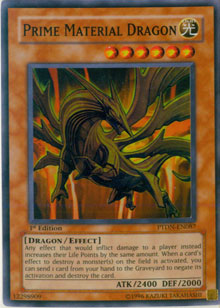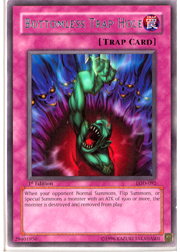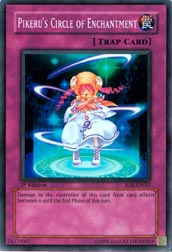 Wow. So how good is Prime Material Dragon?
Wow. So how good is Prime Material Dragon?
This sleeper hit from Phantom Darkness made two big debuts at one big event—the American National Championships last week. Why do I say that it made "two big debuts" when it’s just one card? Well, the Dragon was played in two drastically different ways, and the strategy behind each was very different. Considering where Prime Material Dragon was played, how it was implemented, and what it accomplished, it was practically like watching two different cards explode into the competitive card pool.
On the one hand, Prime Material Dragon was a main-decked powerhouse for tribute-heavy decks. On the other, it was an incredibly powerful, dual-purpose side-deck card stymieing a variety of strategies and play styles. Top-notch side-deck cards for a single matchup are rare enough, but to find something that can be sided against multiple decks, well . . . that’s a true gem. If you’ve been following the tournament coverage from the past week and a half, you’ve already read a bit about this card (and seen it in action), but it really warrants further discussion. My approach to Prime Material Dragon today is going to be similar to the one I took last week when I talked about Kuraz the Light Monarch—I want to examine the Dragon in its two different roles.
First, the Main-Decked Control Engine
Adam Corn set a huge trend when he made Day 2 with a Dark Armed Monarch build main decking two copies of Prime Material Dragon. When I first observed Corn’s deck at the American National Championships, I was struck by the impact of Prime Material on the current top decks. Gladiator Beasts lost the effect of Gladiator Beast Murmillo, and wouldn’t be able to destroy monsters with Gladiator Beast Gyzarus. Dark Armed Dragon and Lightsworn each lost the monster destruction offered by their central Dragon monsters, with Lightsworn also losing the ability to destroy monsters with Ryko, Lightsworn Hunter and Celestia, Lightsworn Angel.
 Bottomless Trap Hole was at an all-time high at American Nats, with many decks playing a full three copies. Prime Material Dragon stops that commonly played removal card, as well as Mirror Force and Torrential Tribute. It can even negate the much-feared Crush Card Virus, just for the cost of a single discard. It’s a really top-notch fit for the current metagame, getting around virtually anything save Caius the Shadow Monarch or Dimensional Prison (both of which saw increased play at Canadian Nationals {link: http://metagame.com/yugioh.aspx?tabid=61&EventId=200} as a result).
Bottomless Trap Hole was at an all-time high at American Nats, with many decks playing a full three copies. Prime Material Dragon stops that commonly played removal card, as well as Mirror Force and Torrential Tribute. It can even negate the much-feared Crush Card Virus, just for the cost of a single discard. It’s a really top-notch fit for the current metagame, getting around virtually anything save Caius the Shadow Monarch or Dimensional Prison (both of which saw increased play at Canadian Nationals {link: http://metagame.com/yugioh.aspx?tabid=61&EventId=200} as a result).
All that was obvious and I stated most of it in the tournament coverage from American Nationals. At that time I felt I had a good understanding of how Prime Material Dragon disrupted opposing decks in common matchups. However, what I didn’t appreciate until after the Championships were over, was what Prime Material Dragon accomplished for Corn’s deck independent of his opponents’ strategies. The one-time National Champion really played this card to the hilt, and its true strength didn’t lie in what Corn was facing, but in what he was playing himself.
Since Corn knew he would be able to protect his monsters from removal a significant portion of the time, he chose to run an extensive lineup of flip effects. Two Gravekeeper’s Spy cards, two copies of Dekoichi the Battlechanted Locomotive, and even a pair of Mask of Darkness cards were ideal tribute bait, as each could get Corn another card through its flip effect before being tributed. While Gladiator Beast Gyzarus and Dark Armed Dragon would normally make this slower approach risky or even impossible, the two copies of Prime Material Dragon offered enough protection in conjunction with Solemn Judgment to ensure that Corn would have a fair shot at flip summoning his flip effect monsters.
 That was huge. It let Corn play Monarchs with an old school style of tactics, scoring free cards off his flip effect monsters before tributing that now-spent piece of field presence for Caius the Shadow Monarch or Thestalos the Firestorm Monarch. It’s a basic strategy, but it’s something we haven’t seen in a reliable form for many months. Such an approach was just too slow when Dark Armed Dragon first hit the scene. When that deck took a hit due to changes made to the Advanced list in May, Monarchs did make a bit of a surge in premier events, but I feel like Prime Material Dragon is the last push they needed to really regain their former glory. The Dragon brings Monarch decks back to their strategic roots and, in doing so, represents a rebirth for the once-mighty archetype.
That was huge. It let Corn play Monarchs with an old school style of tactics, scoring free cards off his flip effect monsters before tributing that now-spent piece of field presence for Caius the Shadow Monarch or Thestalos the Firestorm Monarch. It’s a basic strategy, but it’s something we haven’t seen in a reliable form for many months. Such an approach was just too slow when Dark Armed Dragon first hit the scene. When that deck took a hit due to changes made to the Advanced list in May, Monarchs did make a bit of a surge in premier events, but I feel like Prime Material Dragon is the last push they needed to really regain their former glory. The Dragon brings Monarch decks back to their strategic roots and, in doing so, represents a rebirth for the once-mighty archetype.
No matter what kind of tribute-centric deck you play—Monarchs or otherwise—Prime Material Dragon can help you keep the right monsters on the field to make the ideal tribute plays. It slows down the game, forces out face-up monsters from your opponent, and makes it easier to maintain card presence while still paying tribute costs. Prime Material Dragon is really a huge boon for any deck that wants to rely on tributing, and moving forward, viewing it as such will open up powerful strategic options.
Heck, this bit of theory even carries beyond flip effects and tributing—the Dragon’s a great card for any deck that wants to keep a particular monster on the field too, and we saw that borne out in Yannick Dubeau’s feature match against Jason Tan just this past weekend {link: http://metagame.com/yugioh.aspx?tabid=33&ArticleId=9816}. In that match, Prime Material Dragon let Dubeau keep his all-important copies of Bountiful Artemis on the field, protecting his draw engine and letting him out-card Tan as a result. In the future, it may be worth it to build decks that rely on a particular monster with Prime Material in mind. The fact that it can negate multiple threats (even in the same chain) means that a single Dragon can cover you for the entire duel. Provided you have the infrastructure to support its tribute cost, splashing two copies really isn’t difficult.

But Of Course, That’s Not All
On the flip side, Prime Material Dragon is also superb tech against Gladiator Beasts, stopping Murmillo and Gyzarus in their tracks while also providing a huge body that nothing short of Heraklinos can attack over. A lot of duelists aren’t siding for the burn matchup in their Regionals right now, simply because they don’t expect to see that deck—committing card slots to a matchup you aren’t sure that you’ll face is beyond poor, and that creates a situation where a player who’s unprepared for burn loses to it quite soundly. Prime Material Dragon is so awesome as a side-deck call because it’s not as narrow as other cards played for the burn matchup. If you side it and never face burn, that’s fine—its utility in games 2 and 3 of every Gladiator Beast match you played meant it was a live card anyway.
Tech against the most commonly played deck in the format, rolled into a one-shot answer for the dreaded burn matchup? Why wouldn’t you want to run it?
But again, there are multiple layers here, and not all of them are obvious. Within existing archetypes there’s a lot of room for personalization, and an increasing number of duelists are using that flexibility to play more monster removal. This is an issue of personal style, and the fact that individuality is alive and well in the game—even between different builds of the same archetype—can actually create significant problems for you as a competitive player. If one duelist plays Dark Armed Dragon one way, and another plays it differently, your tech cards for that particular matchup may not always perform as planned. It’s difficult to find tech for particular play styles, because those styles vary so much and are often difficult to predict.
But in this case, we know that many duelists are tapping into the current trend of maxing out on monster removal, and Prime Material Dragon becomes a live side-decking option in those cases no matter what your opponent’s central strategy may be. Whether he or she is playing Counter Fairies, Dark Armed, Lightsworn, or something completely unpredictable, the actual suite of removal cards is often the same, and Prime Material stops virtually all of them. That kind of pan-strategic utility is rare, and it’s a big factor that you should be considering if you side Prime Material Dragon. If you don’t, you might want to think about this perspective a bit more and then reconsider your decision.
There’s a lot more to Prime Material Dragon than first meets the eye, and that’s saying a lot, because even at first glance it’s proven to be highly impressive. But if you understand its full range of strengths, you’re going to get even more out of it than the average competitor. There’s a lot to consider, and it’s easy to get wrapped up in just a handful of the Dragon’s better qualities. If you can go beyond that, you’ll get more out of it than your opponents, placing you at a distinct advantage.
Try it yourself! You won’t believe how useful this once-underrated Dragon can be.
—Jason Grabher-Meyer